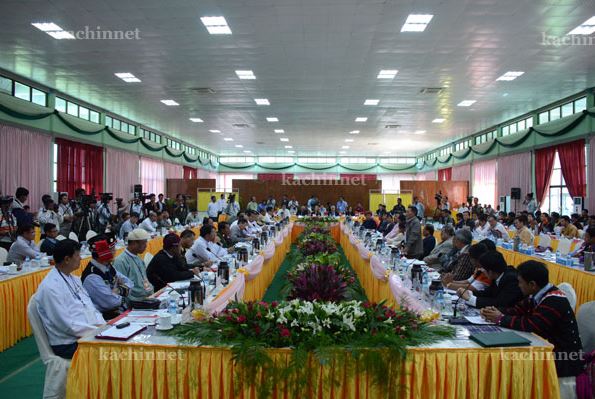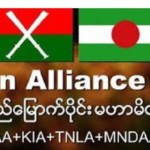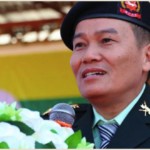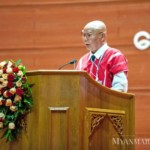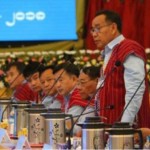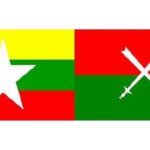Kanbawza Win / Kachinland News, November 5, 2013
In Burma, we will soon witness the inking of a nationwide ceasefire by all the armed ethnic armies with much pomp and ceremony in Naypyidaw attended by international observers and eulogise by the world especially by the West whose appetite for Burma’s natural and human resources knows no bound. Cleverly, manipulated by the ethnic nationalities traitor, Harn Yaunghwe backed by the government and millions of Euros, the real think tanks of UNFC has no choice but succumbed to this formidable force as Tatmadaw continue in its military offensives in Shan, Kachin and any other ethnic strongholds where its fancies may please. In the meantime the ethnic nationalities especially women and children continue to suffer. Of course it is obvious that the two persons the strings from behind will be absent in the ceremony. Than Shwe and Harn. What can you do? The world is like that.
However, the result of Laiza Conference clearly demonstrate that the Kachin came out with flying colours and is the real leader for genuine Pyidoungsu (Union) that would play out in the cause of time with respect to the National Reconciliation process, particularly the talk scheduled to begin today in the capital city of Kachin State, Mythkyina, for the prospect of federalist democracy in Burma. The international observers, the experts alike the stakeholders should be carefully watching.
“Armed conflicts between government troops and armed ethnic groups could rise by 65% if a nationwide ceasefire is not followed by political dialogue”, commented by U Hla Maung Shwe seems to hit the nail on the head,[3] when the raison d’être of the nationwide ceasefire is to legitimise the quasi military government and to attract more foreign investment so that the Tatmadaw backed Thein Sein administration could continue to exploit the people of Burma especially farmers and the working groups residing in the ethnic nationalities area. The hope that people of Burma can one day soon live in an atmosphere of peace and tranquillity depends on the resistance of the people and in their ability to identify the root causes of their suffering, and on the creativity in finding effective ways of addressing those causes so that they can be dealt directly.
The Past
Following World War II, friction between Myanmar and the Non-Myanmar ethnic nationalities, which had been simmering for generations, began rapidly increasing due to the successive Burmese administrations, which was always dominated by the Myanmar ethnic race that refused to take seriously the demands of the ethnic nationalities to exercise authority over their own lands and to be allowed to protect their traditional languages and cultures. The issue gradually escalated towards open civil war until finally, in 1949, the Karen and Mon started their armed revolutions against the central government. Later, other ethnic nationalities such as the Kachin, Shan, and Arakan etc. also followed the course of armed revolution until today there is no ethnic nationality that is not fighting the Myanmar dominated Central Government.
The then civilian government called the ethnic leaders together for talks to find a solution in early 1962. But before it can do anything, Gen. Ne Win, made a coup and set up the “Revolution Council”. This action proves that Tatmadaw government consider the ethnic nationalities issue as simply Burma’s heritage from their British colonizer’s divide and rule strategy rather than critically seeking to understand what historical issues the ethnic nationalities groups were upset about. Thus the nation, under Ne Win, moved into a time of ever intensifying hostilities. All negotiations initiated by the Tatmadaw regime focused, not on developing a truly democratic process which could settle the ethnic issues facing the country, but rather only on a process of uniting the country as one single state at the expense of the ethnic rights.
For the ethnic nationalities, this concept of “national unity” by the Tatmadaw sounded as an open process of “Myanmarnization”. The Burmese language was being used as the common language for teaching in all the schools while it was forbidden to teach in the individual ethnic languages of each group. Moreover, members of the various ethnic nationalities were moved out of almost all important government and military positions. Any demands by the ethnic nationalities to rectify these, and many other similar issues were construed by the Tatmadaw as being activities to disrupted national unity. Rather than moving the country closer to national unity, Tatmadaw’s policies actually drove the wedge of fear and suspicion even deeper between the ethnic nationalities and the Myanmar majority.
The nation’s second Constitution, drawn up in 1974 by Gen. Ne Win and his Revolutionary Council, created the Burma Socialist Program Party (BSPP) as the country’s only legal party, without consulting with the ethnic nationalities. The BSPP was simply a Tatmadaw party in civilian dress in as much as the vehemently hated USDP (Union Solidarity and Development Party) today is. The nation was geographically divided into seven states and seven divisions. The new Constitution not only disregarded the essence of Panglong Agreement, but also constitutionally expanded Myanmar ethnic national domination toward non-Myanmar ethnic nationals. Although these divisions were meant to give the appearance of at least some ethnic nationalities autonomy, the representatives from these states were in fact drafted by the BSPP and did not represent the ethnic nationalities at all.
At the same time Ne Win transferred many ex-soldiers into the BSPP and thus the country came under an extremely strong centralized military control policy, further alienating the ethnic nationalities. Although several “new administrations have come and gone, the issue of the ethnic conflict and the resulting civil war remains untouched. This war continues to result in a multiplicity of human rights abuses which can never be brought under control as long as the war and its causes are not dealt with directly and with the utmost urgency.
The Tatmadaw also initiated political suppression against all activists including rightist, leftist and nationalist throughout the country. But, the people of Burma have never accepted this Tatmadaw misrule and so they has to invest a large amount of national budget into building up the Tatmadaw strong enough to keep the population under control in every economic, political and social aspect of life.
In 1988, unrest over economic mismanagement and political oppression by the government led to widespread pro-democracy demonstrations throughout the country known as the 8888 Uprising. Security forces killed tens of thousands of demonstrators, and General Saw Maung staged a coup d’état and formed the State Law and Order Restoration Council (SLORC) which later re name as SPDC. In May 1990, the government held free elections for the first time in almost 30 years. The National League for Democracy (NLD), the party of Aung San Suu Kyi, won 392 out of a total 489 seats, but the election results were annulled by SLORC, which refused to step down. On February 17, 2005, the government reconvened the National Convention, for the first time since 1993, in an attempt to rewrite the Constitution. However, major pro-democracy organisations and parties, including the National League for Democracy, were barred from participating; the military allowing only selected smaller parties. None of the ethnic nationalities participated except the cronies. The drafting of this constitution took nearly 15 years [4] while 1974 Socialist Constitution took only 7 months. Why? Because they endeavour to find the raison d’être to establish the Tatmadaw as an ultra-constitutional authority and will always be above the constitution and above the law in perpetuity. In fact it was the institution which abandoned both constitutions by coups, 1947 and 1974 and now the new Nargis Constitution of 2008 and justifies itself as a responsible for safeguarding the State Constitution.
Myanmarnization by militarization has resulted in increased poverty and political repression of the entire country and only military officers, collaborators and cronies are the only groups to share the benefits in the country. Under such conditions, dissidents seem to have no alternative to work for change within the legal process, and have little reason to believe that the present 2008 Nargis Constitution will truly pave the way towards a democratic system independent of Tatmadaw manipulation. Therefore, many have left Burma for other countries either legally or illegally. A large majority of them have resorted to armed revolt as the only way left to respond. Hostilities have thus intensified resulting in even more human rights abuses throughout the country.
In order to cut the opposition off from people living in the area, the Tatmadaw has initiated massive relocation programs which move villagers into controlled camps within military control. From these camps, people can also be recruited for forced labour to build roads, railways, and to serve as porters. Over 2.5 million people throughout Burma have probably already been displaced in these military operations. In Western Burma of the Arakan State, there is no very active guerrilla activity, but the local Muslim population, known as Mujahids now calling themselves Rohingyas, are suffering severely from the military’s systematic suppression policy. Nearly 300,000 fled to neighbouring Bangladesh to seek refuge, as ethnic cleansing is going on with might and main. There is presently no way the international community can be assured that these Rohingyas will be safe if sent home.
But as of two years the Tatmadaw leaders began realise its folly of losing its independence to China and Burma start to change and slowly inches towards civilization and endeavour to solve the problems by negotiations but still the it needs to be emphasized that human rights abuses will continue unabated as long as the present military structure remains unchanged, as long as the reasons for ethnic tensions are not identified and dealt with.
The Present
It is vividly clear that the ethnic nationalities want political dialogue. The government wants a formal deal to end armed conflict with the focus on legitimacy and attracting foreign investment. The latter harbour some ulterior motive while the former have some genuine desire. The meeting between the United Nationalities Federal Council (UNFC), an umbrella organization of ethnic armed groups and the government delegation by Aung Min was not successful as the government continue to use its age old policy of “Divide and Rule Strategy” On the other hand the UNFC is writing a draft of an entirely new constitution, pushing for a federalist system that would offer more power to ethnic states, while the government delegation says there is no need to even amend the existing charter.[5]
The ruling Union Solidarity and Development Party (USDP) warned of grave danger and bad consequences if the 2008 constitution is abolished and redrawn.[6] It is to be noted that former leaders remain in government and Parliament, and it is difficult to imagine that they genuinely wish to amend the Constitution, which many of them helped draft undemocratically. The charter guarantees that they will continue to play a key role in politics, retaining their hold on important businesses and amassing even greater wealth at the country and people’s expense. It is true that Parliament has formed a committee to review the 2008 document, but not everyone in Naypyidaw including President Thein Sein himself seems so supportive.[7] If the president is blocking constitutional change, he is not the only one. Most leaders of the ruling Union Solidarity and Development Party (USDP) are also obstructing this type of reform, along with high-ranking members of the military, and Daw Aung San Suu Kyi is not oblivious. The Nobel Peace Prize laureate knows that any amendments will require the blessing of former generals who once held her under house arrest and who continue to remain in power today.
The ethnic leaders want to prioritize a comprehensive political dialogue,[8] as everybody agreed that what the Tatmadaw did today to the Kachin IDPs especially in Mung Ding Pa is really terrible and unacceptable as the village is not a KIA stronghold. What they did to them does not arguers well for a country transitioning to democracy.[9]
Adding to Daw Aung San Suu Kyi’s difficulties, opposition parties and ethnic groups lack unity on the issue of constitutional change. There are two camps. One side, including Suu Kyi’s National League for Democracy (NLD), wants to amend the Constitution. The other side, including a majority of ethnic groups, wants to completely discard the current charter and rewrite a new one. There is no question that Burma needs a democratic Constitution, and for that, the current charter will need to be amended or rewritten. However, hopeful, the Burmese people should not forget the mentality of those generals who lead the country still want to have a lion’s share for them. Constitutional change is crucial, and we should be careful that any attempt to achieve it is not counterproductive.
The peace deal has been initiated from the top-down, rather than from the grassroots, although communities on the ground will be affected most by whatever deal is reached. Over six decades, almost all armed groups have dealt with the government individually, signing a first round of ceasefire agreements in the 1980s and 1990s. Ethnic Karen, Shan, Mon, Kachin, Karenni and Chin groups all signed ceasefires. But most of these ceasefires broke down after the military regime tried to implement its plan for a Border Guard Force (BGF). Now it has come with one voice.
The only ethnic group that did not want to coexist with the Myanmar ethnic group is the WA. The WA rebels comprise the strongest armed group in the country, the United WA State Army (UWSA), with an estimated 30,000 troops and a solid stock of modern weapons, have been the boldest with their claims, calling for an “autonomous region” within Shan State and indicating that they are ready to wage war any time if their demands are not realized. WA rebels do not want to co-exist with Thein Sein’s administration and is the only ethnic group like their Myanmar counterpart that did not harbour the Pyidoungsu (Union) spirit and has refused to attend the Laiza Conference.[10] Every patriotic Burmese clearly sees the hands of China pulling the strings of the WA as the Chinese want to see Burma weak and exploit the country’s human and natural resources for its own purpose. In other words want to make Burma their client state and exploit it to their heart’s content as it had done before Burma change.
Many ethnic armed groups have called for constitutional amendments, political dialogue and the withdrawal of government troops from their territory. To a large extent, these demands have been turned down—either directly or indirectly—by Naypyidaw, which continues to prioritize a nationwide ceasefire first while its army continue to attack the ethnic positions. As a result, ethnic groups remain divided between soft factions, who will ignore political demands while engaging with the government on economic and social development, and the political inclined factions, such as the UNFC, which have been criticized for being strong in principle but weak in action. Lamentably the Karen National Union (KNU), one of the strongest ethnic groups has giving into the government’s demands pushing forward a number of major development projects in resource-rich Karen State, without the approval of the people as the new crop of Karen leaders are economically inclined and not so much on their traditional political solutions.
If the nationwide ceasefire agreement is reached as planned at least in name then, the international community will likely cheer and offer support for the country’s reforms. But the divided ethnic groups will remain at crossroads. It is time for ethnic armed groups to strongly demand what they really want, and to stop engaging with the government if their calls are not realized. The ethnic nationalities should recollect that coexistence with the Myanmar-dominated government will never last long, unless the Myanmar-led government respects and realizes the demands of the armed Non-Myanmar ethnicities. The ethnic armed groups should also initiate, rather than waiting for government-initiated programs. But the trump card is that the draft treaty had yet to be approved by Burma’s National Defense and Security Council, the real power behind the throne of Thein Sein.
The Future
The future of Burma lies in the hands of the ethnic nationalities and that of the hard line military faction led by Than Shwe under the disguised of National Defense and Security Council. The meeting at Laiza clearly indicated that ethnic freedom fighters groups are willing to take the first step towards peace by inking a nationwide ceasefire agreement next month.[11] The 18 armed groups had compelled the Myanmar dominated government into accepting a federal union that guarantees political autonomy for their ethnic regions, as a first step. In fact President Thein Sein’s reformist government has earned much international praise after it signed ceasefire agreements with 14 groups since assuming office in 2011. It is now keen to cap this progress with a nationwide ceasefire agreement. UNFC chairman N’Ban La urged ethnic representatives remarked.“We can no longer repeat the mistakes from the past. We must be brave. It is no longer possible to go along with a sham federal union. The different ethnic nationalities groups may have different ideas and approaches, but we generally have the common goal of federalism. ”
It should be recollected that even in the Panglong Conference of 1947, the Arakanese, Mon. Karen and Karenni were not invited but now all the representatives of the armed group of ethnic nationalities except the WA (at the Chinese insistent describe above) had attended. History has indicated that the British administration which was based on modern democracy and capitalism superseded the Burmese autocratic feudalism, which had treated other ethnic nationalities under their domination as serfs. The peaceful situation during the British reign gave an opportunity for most of the ethnic non-Myanmar refugees who had fled the ruthless brutal oppression of the Myanmar kings to neighboring countries, to return to Burma. Now is the golden chance.
One should bear in mind that a dictatorship is only as strong as the size of the weapons it holds and the fear those weapons provoke in the people, whereas, democracy is only as strong as the understanding and support the grassroots people have of it.[12] Human rights abuses, like obnoxious weeds, cannot simply be wished away. Both are created and supported by roots which keep bearing new weeds as long as those roots remain intact and nourished. To eradicate both human rights abuses and obnoxious weeds, the central roots must be identified and removed. In Burma, the decades-long experience of human rights abuses is deeply rooted in the militarization compounded by Myanmarnization which has characterized the country since 1962. This militarization has exasperated ethnic tensions, which has, in turn, created a civil war in which human rights abuses will never abate unless the war itself is finally brought to an end. And with the mentality of the Tatmadaw, this will never happens because Tatmadaw alone will not honour the ceasefire and still construe the ethnic nationalities as a subject of colonization.
The primary task in Burma, therefore, is the dismantling of the Tatmadaw machine and its system of its total control over the economic, social and political life of the country, which the quasi civilian administration led by Thein Sein is trying to accomplish. It is just a start of the long process of healing but it is an essential task. The Nargis Constitution of 2008 stipulates that at any time if the Tatmadaw construe that the country is in danger then it is legal for the Tatmadaw to make a coup. A sort of a Sword of Damocles, to prove that they are the custodians of the country little knowing that once this military system is removed, the civil war can come to an end, national reconciliation begun and human rights abuses addressed in a constructive and decisive way.
A flexible ethnic identity is an important survival strategy, allowing people to maintain or even integrate with the other cultural, economic and political systems. One can add that despite this natural tendency towards change, people resist certain forms of change which threaten their well-being. Political movements often organize this resistance around a nationalist message. However, by defining a vision of ethnic identity and imposing it for political ends, ethnic nationalism threatens people’s ability to adapt their identity to suit a changing environment. At some point, the natural need for flexibility and the imposed needs of ethnic nationalism collide, creating a dilemma for the social justice movement. What do these ideas suggest to the peace movement about its goals and mechanisms? How does this fluidity of ethnic identity relate to the Burmese Military authority’s policy of Myanmarnization, a systematic campaign to nullify ethnic diversity by creating a single national culture based on Myanmar language, culture and religion? How does one reconcile the necessities of a spontaneous survival strategy with an imposed political program to manipulate it? Are some of the answers to be researched?
Language plays and important part in the struggle to define the nature of social change. Like culture and ethnicity, language is also in constant flux, and is a major tool for resistance and adaptation.[13] For a man to speak one language or another is a ritual act, it is a statement about one’s personal status; to speak the same language as one’s neighbours expresses solidarity with those neighbours, to speak a different language from one’s neighbours expresses social distance or even hostility. Multilingualism is a fact of life in Burma, where many people are conversant in three or more languages and dialects. Opportunities abound to use language as a social indicator. It is no surprise that ethnic nationalism, social change, resistance and adaptation, and the peace movement collide over language. Myanmar and non Myanmar nationalism are conveyed through language both as an identifier of ethnicity (one is what one speaks) as well as through a main institutional agent of social control, education.
Humanitarian motives, influenced by ethnic nationalism, urgency for the preservation of cultures, and even nostalgia for agrarian paradises or utopia, the principle of all conservative ideologies cause one to lose sight of Burma’s social realities. Although Burmese language skill may be an essential survival tool for ethnic languages facing changing political and economic conditions, it also represents acceptance, or even absorption, by the mainstream.
Currently the global media’s infatuation with Daw Aung San Suu Kyi, and her wilful misrepresentation and endorsement of Burma’s fatally flawed political process, has done incalculable harm to hopes of a genuine democracy and federalism.[14] With her being co-opted by the Tatmadaw controlled government, the Non-Myanma ethnic nationalities face a ghastly choice: to be coerced into signing ‘peace agreements’ that will turn them into impoverished wage slaves on their own land in the service of Myanmar or foreign crony capitalists; or continue to resist, and risk annihilation. Now it is time for the international community to push the regime from the back as the ethnic nationalities pull the strings from the front on the real road to democracy and federalism.
The author can be contacted directly at bathannwin@gmail.com
This article originally appreared in Kachinland News. View the original article here.

